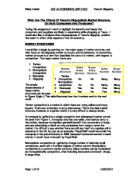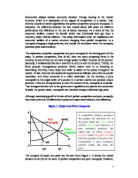Using transport examples throughout, explain the impact of market structure on economic efficiency and the ability of firms to set prices and make profits
Using transport examples throughout, explain the impact of market structure on economic efficiency and the ability of firms to set prices and make profits
Economic efficiency is the use of resources in such a way as to maximise the production of goods and services. The structure of a market, its profitability, prices and output can affect its economic efficiency.
There are four main types of efficiency to consider; productive efficiency, allocative efficiency, dynamic efficiency and X-inefficiency. Productive efficiency is at its maximum when the level of production is at the minimum of the Average Cost curve. Productive efficiency is at its maximum when price is equal to marginal cost.
Dynamic efficiency is through the generation of abnormal profits (AR>AC), that are invested for future development. X-inefficiency is when a firm is not operating at minimum cost, due to organisational slack.
Using the market structure of perfect competition as an example, there are many small firms producing homogenous goods, thus it is fragmented as opposed to concentrated. In the transport industry the local coach travel market represents the model of perfect competition quite well.
No one firm can set of affect the price level, and so the firms are referred to as 'price-takers'. If a firm decided to sell their good or service at a price higher than that of others, consumers would simply demand from another supplier due to the homogenous nature of the good or service. If a firm sold their goods/services at a price less that the market selling price, then they would simply make losses. Because of this, there is one market selling price at all levels of output, and so the demand curve is horizontal, matching with the average revenue and marginal revenue curves.
Another condition of perfect competition is that of perfect information, consumers are aware of other firms within the market from which they could purchase homogenous goods if one firm prices too high. There are also no or low barriers to entry; in reality there are always barriers to entry, however in the perfect competition is a theory and so no barriers to entry is a condition of this theory. Using real life examples however, such as the local coach travel market, there are of course barriers to entry; however these can be low, such as hiring a coach and having a driver with sufficient health and safety licenses.
In terms of economic efficiency, in theory, perfect competition achieves both productive and allocative efficiency and has no X-inefficiency.
Productive efficiency is reached in perfect competition because the profit maximising quantity of output is where the long-run average cost is at its minimum, and so production is at the lost unit cost. Allocative efficiency is reached because the cost of producing one more unit level of output is equal to the price, and so P=MC. It is also reached when consumer are provided with the goods and services which they want. X-efficiency or no X-inefficiency is reached ...
This is a preview of the whole essay
In terms of economic efficiency, in theory, perfect competition achieves both productive and allocative efficiency and has no X-inefficiency.
Productive efficiency is reached in perfect competition because the profit maximising quantity of output is where the long-run average cost is at its minimum, and so production is at the lost unit cost. Allocative efficiency is reached because the cost of producing one more unit level of output is equal to the price, and so P=MC. It is also reached when consumer are provided with the goods and services which they want. X-efficiency or no X-inefficiency is reached because costs are reduced to a minimum and so there is no organisational slack. Firms within the perfect competition model will make normal profits in the long-run due to the condition that average revenue is equal to average costs; however in the short-run firms can make abnormal profits or losses. Short-run abnormal profits will attract competitors to enter the market and so it will become more fragmented and competitive in the long-run, reducing abnormal profits to normal profits.
The fact that normal profits are made in the long-run in perfect competition means that there is no dynamic efficiency due to lack of abnormal profits for long-term investment and innovation.
Perfect competition is merely a theory and so does not exist in practice, however within the transport market structure there are examples of highly competitive markets, such as the local coach travel market, which is highly fragmented, provides a homogenous product and service, there are many participants (buyers and sellers), low barriers to entry and exit, there is high knowledge of market conditions and the firms' objectives are to maximise profits. This in turn means that compared to less competitive markets, there is higher output within the market, and the price is lower than other, less competitive markets.
These less competitive markets can be seen as 'monopolies' or 'oligopolies'.
Monopolies typically have characteristics converse of those of perfect competition.
A monopoly arises when one firm is a single seller of a good or service, there are no substitutes for the good, and there are high barriers to entry into the market. This market power and dominance is gained through brand loyalty, high barriers to entry such as sunk costs, economies of scale, regulation or control of resources. Compared to the 'price-takers' of perfect competition, monopolistic firms are 'price-makers' and so can set prices as they wish. For this reason the demand curve in a monopoly is downward sloping compared to horizontal in perfect competition.
Monopolistic firms are constantly able to make abnormal profit, whether it is in the short or long term. This is because average revenue is always greater than average cost. Economic efficiency in monopolistic markets suffers due to underproduction and high prices. Productive efficiency is not achieved because output is at a level less than that of minimum average cost, where LRAC is falling. This also means the firm is not exploiting economies of scale to the maximum. Allocative efficiency is not reached because price is greater than marginal cost and X-inefficiency is large due to the firm no operating at minimum cost causing possible organisational slack. Dynamic efficiency however could be experienced due to the abnormal profits being made, possibly being re-invested into the future of the firm and innovation.
Using an example from the transport industry, the Virgin Trains service between Manchester and London is monopolistic, like many other mainline routes which are also franchised for a number of years. Virgin Trains experiences all of characteristics of a monopoly along this route for the duration of the franchise. Due to the fact they are a 'price-maker' on the route, they are able to price discriminate; charging each customer a different price and extracting as much consumer surplus as possible to make it consumer surplus. They do this by charging a price that reflects the consumers' willingness to pay, for instance a business man travelling at a peak time for a business meeting will be willing to pay a large sum, especially if his company are paying, and so he will be charged a large sum; however a family travelling for a trip and paying far in advance will pay a lot less, and possibly less that the market selling price at P(mp).
This increases Virgin's abnormal profit and also benefits those who are only willing to pay less than the market selling price.
Another market structure that is worth noting in terms of economic efficiency is that of an 'oligopoly'. In an oligopoly there are few sellers and each firm must take account of the behaviour and likely behaviour of rival firms in the industry because they are interdependent. The n-firm concentration ratio of oligopolies is high, with a few firms taking up a majority share of the market.
Behaviour of oligopolistic firms can be either 'cut-throat' competition to maximise market share through competitive and non-collusive behaviour, or formal cooperation/tacit collusion to split the market up and divide it between firms. We assume that there are, high barriers to entry to an oligopolistic market due to large-scale production and strong branding, price rigidity due to the risks of competitive pricing and thus non-price competition to gain market share, firm's LRAC curves are 'L-shaped' rather than 'U-shaped' because the MES extends over a large range of output.
The 'kinked-demand' theory suggests that if one firm in an oligopolistic market increases price then other firms will not follow because the level of output decreases far too greatly relatively and they will be able to sell more, due to the asymmetric PED, however if one firm lowers price, others will follow suit and also decrease their prices so as not to lose market share.
When firms within an oligopoly compete through non-collusive behaviour, the market behaviour becomes very much like that of perfect competition, with increased productivity and lower prices, meaning increase productive efficiency and allocative efficiency, with also lower X-inefficiency through lower costs and profit maximisation, thus less organisational slack.
Overall we can say that as a market structure becomes less efficient, the firms within that market are able to set prices and make profits with more ease. With high efficiency, normal profits and hardly any ability to set prices in competitive markets, and low efficiency, abnormal profits and the ability to manipulate the market selling price in markets that have little or low competition with a high n-firm concentration ratio.








